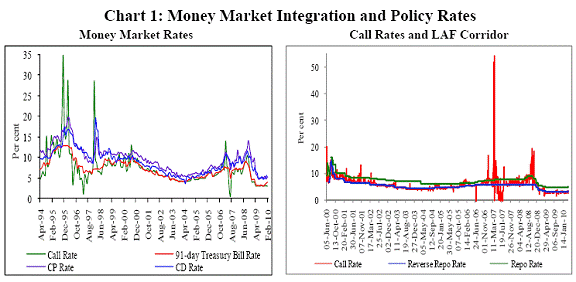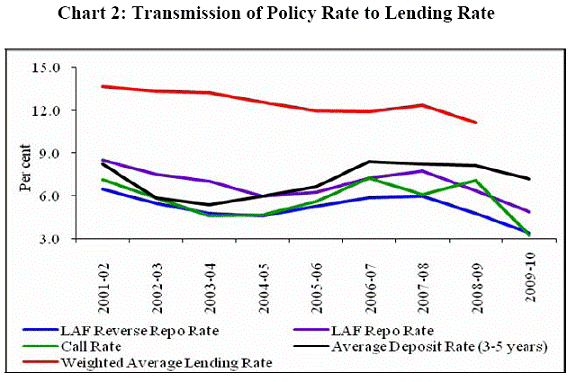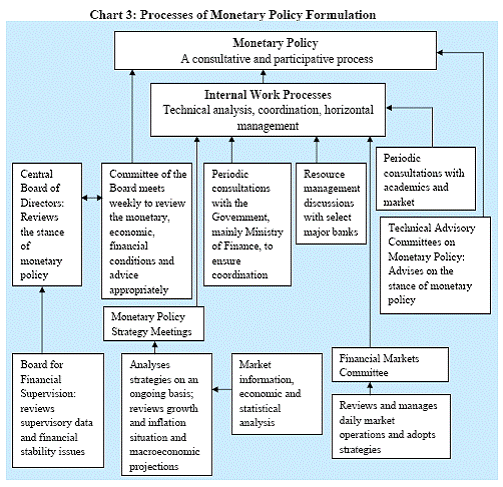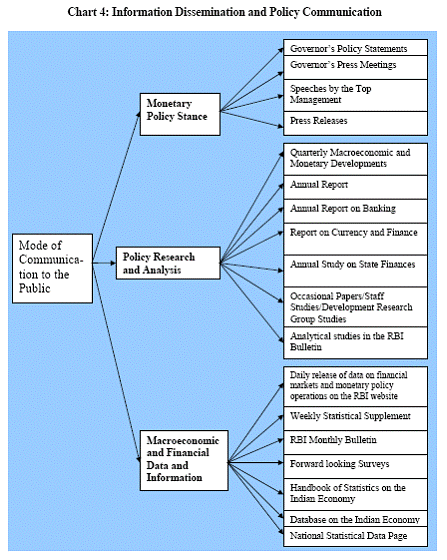Implementation of Monetary Policy in India - आरबीआय - Reserve Bank of India


Implementation of Monetary Policy in India
Shri Deepak Mohanty, Executive Director, Reserve Bank of India
delivered-on मार्च 15, 2010
I thank the Bankers Club, Bhubaneswar for providing me this opportunity to speak to you this evening. How does the Reserve Bank of India implement monetary policy? This is the question I would like to address. But before doing that I will briefly touch upon the objectives and framework of monetary policy, as they have evolved, to set the context for discussion on operational aspects of monetary policy. I will conclude with a discussion on the process of monetary policy formulation and communication. Objectives and Framework In India, the objectives of monetary policy evolved as maintaining price stability and ensuring adequate flow of credit to the productive sectors of the economy. With progressive liberalisation and increasing globalisation of the economy, maintaining orderly conditions in the financial markets emerged as an additional policy objective. Thus, monetary policy in India endeavours to maintain a judicious balance between price stability, economic growth and financial stability. The monetary policy framework in India from the mid-1980s till 1997-98 can be characterized as a monetary targeting framework on the lines recommended by Chakravarty Committee (1985). Because of the reasonable stability of the money demand function, the annual growth in broad money (M3) was used as an intermediate target of monetary policy to achieve the final objectives. Monetary management involved working out M3 growth consistent with projected GDP growth and a tolerable level of inflation. In practice, however, the monetary targeting approach was used in a flexible manner with ‘feedback’ from the developments in the real sector. For example, if the real GDP growth was expected to be higher, M3 projection was revised upwards. In the 1990s, the increasing market orientation of the financial system and greater capital inflows imparted instability to the money demand function. Consequently, there was a shift to multiple indicators approach in the late 1990s. Under this approach, interest rates or rates of return in different markets along with movements in currency, credit, fiscal position, trade, capital flows, inflation rate, exchange rate, refinancing and transactions in foreign exchange – available on a high frequency basis – are juxtaposed with output data for drawing policy perspectives. The multiple indicators approach continued to evolve and was augmented by forward looking indicators and a panel of parsimonious time series models. The forward looking indicators are drawn from the Reserve Bank’s industrial outlook survey, capacity utilization survey, professional forecasters’ survey and inflation expectations survey. The assessment from these indicators and models feed into the projection of growth and inflation. Thus, the current framework of monetary policy can be termed as augmented multiple indicators approach1. Operating Procedure Operating procedure refer to the day to day management of monetary conditions consistent with the overall stance of monetary policy. It is in essence the ‘nuts and bolts’ of monetary policy. It involves: first, the choice of the operational target; second, the nature, extent and the frequency of different money market operations by the central bank; third, the use and width of the corridor for very short-term market interest rates and; finally, the manner of signalling policy intentions. The choice of the operating target is crucial as this variable is at the beginning of the monetary transmission process. The operating target of a central bank could be bank reserves, base money or a benchmark interest rate. While actions of a central bank could influence all these variables, the final outcome is determined by the response of financial markets and institutions to the central bank action. I will briefly survey the international experience before turning to our own experience. International Experience Among the two operating targets ─ bank reserves and interest rates ─ the focus increasingly shifted towards interest rates in the early 1990s reflecting greater significance of interest rates in the monetary transmission mechanism as markets developed in a deregulated environment. Consequently, the overnight rate emerged as the most commonly pursued operating target in the conduct of monetary policy. For example, developed countries such as the US, the UK, Japan, Canada and Australia focus on the overnight inter-bank rate as the key operative target. The European Central Bank (ECB) follows a corridor approach for short-term market interest rates with a floor provided by its deposit facility and the ceiling by its marginal lending facility. The ECB provides liquidity through its main refinancing operations to ensure that the demand-supply conditions in the inter-bank market support a short-term inter-bank market interest rate consistent with its interest rate target.While many emerging market economies (EMEs) target overnight interest rate, there is also a preference for an interest rate corridor. Literature on the central banks’ own accounts in the industrial countries attribute five main reasons for reforms in their operating procedures during the 1980s and the 1990s2.
Thus, during the 1990s there was continuous reduction in reserve requirements with increasing emphasis on active liquidity management accompanied by a greater transparency in the policy signals relating to desired interest rate levels. Most central banks prefer open market operations (OMO) as a tool of monetary policy, which allow them to adjust market liquidity and influence the term structure of interest rates. Indian Experience Consistent with the objectives and policy framework, the operating procedure of monetary policy in India has also witnessed significant changes. The choice of targets, instruments and operating procedure was circumscribed to a large extent by the nature of the financial markets and the institutional arrangements. During the monetary targeting period (1985-1998), while M3 growth provided the nominal anchor, reserve money was used as the operating target and cash reserve ratio (CRR) was used as the principal operating instrument. Besides CRR, in the pre-reform period prior to 1991, given the command and control nature of the economy, the Reserve Bank had to resort to direct instruments like interest rate regulations and selective credit control. These instruments were used intermittently to neutralize the expansionary impact of large fiscal deficits which were partly monetised. The administered interest rate regime kept the yield rate of the government securities artificially low. The demand for them was created through periodic hikes in the Statutory Liquidity Ratio (SLR) for banks. The task before the Reserve Bank was, therefore, to develop the financial markets to prepare the ground for indirect operations. The year 1992-93 was a landmark in the sense that the market borrowing programme of the government was put through the auction process. This was buttressed by a phased deregulation of lending rates in the credit market. The Reserve Bank also brought down the SLR to its statutory minimum of 25 per cent by October 1997, while CRR was brought down from 15 per cent of net demand and time liabilities (NDTL) of banks to 9.5 per cent by November 1997. The automatic monetization of deficits was also phased out in April 1997. All these developments resulted in a decline in pre-emption of resources from the banking system from a peak of 63 per cent in 1992 to 35 per cent by 1997. The Narsimham Committee (1998), however, noted that the money market continued to remain lopsided, thin and volatile and the Reserve Bank also had no effective presence in the market. Therefore, it reiterated the need to transform the call money market into a pure inter-bank market and recommended the Reserve Bank’s operations to be market-based. Following these recommendations, the Reserve Bank introduced the liquidity adjustment facility (LAF) in June 2000 to manage market liquidity on a daily basis and also to transmit interest rate signals to the market. Under the LAF, the Reserve Bank’s policy reverse repo and repo rates set the corridor for overnight market interest rates. Thus, OMO including LAF emerged as the dominant instrument of monetary policy, though CRR continued to be used as an additional instrument of policy. The call money market was transformed into a pure inter-bank market by August 2005 in a phased manner. Concomitantly, to enable a smooth exit of non-banks, new instruments such as the collateralized borrowing and lending obligations (CBLO) were introduced in January 2003. With the introduction of prudential limits on borrowing and lending by banks in the call money market, the collateralized money market segments developed rapidly. Maturities of other money market instruments such as commercial papers (CPs) and certificates of deposit (CD) were gradually shortened to seven days in order to align the maturity structure. Managing large and persistent capital inflows in excess of the absorptive capacity of the economy added another dimension to the liquidity management operations during the 2000s. Although, initially the liquidity impact of large capital inflows were sterilised through OMOs and LAF operations, given the finite stock of government securities in the Reserve Bank’s portfolio and the legal restrictions on issuance of its own paper, additional instruments were needed to contain liquidity of a more enduring nature. This led to the introduction of the market stabilisation scheme (MSS) in April 2004. Under this scheme, short-term government securities were issued but the amount remained impounded in the Reserve Bank’s balance sheet for sterilisation purposes. Interestingly, in the face of reversal of capital flows during the recent crisis, unwinding of such sterilised liquidity under the MSS helped to ease liquidity conditions. In response to the measures taken to develop the money market, over the years the turnover in various market segments increased significantly. All these reforms have also led to improvement in liquidity management operations by the Reserve Bank as evident from the stability in call money rates, which also helped improve integration of various money market segments and thereby effective transmission of policy signals (Charts 1). The rule-based fiscal policy pursued under the Fiscal Responsibility and Budget Management (FRBM) Act, by easing fiscal dominance, contributed to overall improvement in monetary management.
Notwithstanding such improvements at the short-end of the financial market spectrum, the transmission of the policy signals to banks’ lending rates has been rather slow given the rigidities in the system, particularly the preference for fixed interest rate on term deposits. Against the backdrop of ample liquidity in the system more recently, as banks have reduced their deposit rates, the effective lending rates would have shown further moderation (Chart 2).
Policy Formulation Processes The process of monetary policy in India had traditionally been largely internal with only the end product of actions being made public. The process has overtime become more consultative, participative and articulate with external orientation. The internal work processes have also been re-engineered to focus on technical analysis, coordination, horizontal management and more market orientation. The process leading to monetary policy actions entails a wide range of inputs involving the internal staff, market participants, academics, financial market experts and the Bank’s Board (Chart 3).
Several new institutional arrangements and work processes have been put in place to meet the needs of policy making in a complex and fast changing economic environment. At the apex of the policy process is the Governor, assisted closely by Deputy Governors and guided by deliberations of the Board of Directors. A Committee of the Board meets every week to review the monetary, economic and financial conditions and renders advice on policy. There are several other standing and ad hoc committees or groups which play a critical role with regard to policy advice. An interdepartmental Financial Markets Committee focuses on day-to-day market operations and tactics while periodic monetary policy strategy meetings analyse strategies on an ongoing basis. Information Dissemination and Policy Communication It is generally believed that greater information dissemination and policy communication could lead to better policy outcome. It is, however, not clear as to what extent the communication would result in shaping and managing expectations. For example, the US Federal Reserve, since 1994, appears to have been providing forward guidance, while the ECB appears to be in the mould of keeping the markets informed rather than guiding it. In India, a middle path is followed by sharing of both information and analysis. The stance of monetary policy and the rationale are communicated to the public in a variety of ways, the Governor’s most important being the quarterly monetary policy statements. Further, the policy measures are analysed in various statutory and non-statutory publications, speeches and press releases. Information on areas relating to the economy, banking and financial sector is released with stringent standards of quality and timeliness. Dissemination of information takes place through several channels (Chart 4). The Reserve Bank has also developed a real time database on the Indian economy, which is available to the public through its website.
Conclusions With the changing framework of monetary policy in Indian from monetary targeting to an augmented multiple indictors approach, the operating targets and processes have also undergone a change. There has been a shift from quantitative intermediate targets to interest rates, as the development of financial markets enabled transmission of policy signals through the interest rate channel. At the same time, availability of multiple instruments such as CRR, OMO including LAF and MSS has provided necessary flexibility to monetary operations. While monetary policy formulation is a technical process, it has become more consultative and participative with the involvement of market participant, academics and experts. The internal process has also been re-engineered with more technical analysis and market orientation. In order to enhance transparency in communication the focus has been on dissemination of information and analysis to the public through the Governor’s monetary policy statements and also through regular sharing of policy research and macroeconomic and financial information.* Speech by Deepak Mohanty, Executive Director, Reserve Bank of India, delivered at the Bankers Club, Bhubaneswar on 15th March 2010. The assistance provided by Shri Bhupal Singh and Shri Binod B. Bhoi is acknowledged. 1 Mohanty, Deepak (2010), “Monetary Policy Framework in India: Experience with Multiple-Indicators Approach”, Speech delivered at the Conference of the Orissa Economic Association in Baripada, Orissa, on February 21, 2010. 2 Mehran H., Laurens, B. and M. Quintyn (eds.) (1996), Interest Rate Liberalization and Money Market Development: Selected Country Experiences, Washington, DC: International Monetary Fund. |


























